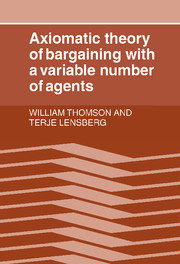Book contents
- Frontmatter
- Contents
- Acknowledgments
- List of symbols and notation
- List of axioms
- 1 Preliminaries
- 2 Axiomatic theory of bargaining with a fixed number of agents
- 3 Population Monotonicity and the Kalai–Smorodinsky solution
- 4 Population Monotonicity and the Egalitarian solution
- 5 Truncated Egalitarian and Monotone Path solutions
- 6 Guarantees and opportunities
- 7 Stability and the Nash solution
- 8 Stability without Pareto-Optimality
- 9 Stability and the Leximin solution
- 10 Population Monotonicity, Weak Stability, and the Egalitarian solution
- 11 Stability and Collectively Rational solutions
- 12 Invariance under Replication and Juxtaposition
- Bibliography
- Index
2 - Axiomatic theory of bargaining with a fixed number of agents
Published online by Cambridge University Press: 23 March 2010
- Frontmatter
- Contents
- Acknowledgments
- List of symbols and notation
- List of axioms
- 1 Preliminaries
- 2 Axiomatic theory of bargaining with a fixed number of agents
- 3 Population Monotonicity and the Kalai–Smorodinsky solution
- 4 Population Monotonicity and the Egalitarian solution
- 5 Truncated Egalitarian and Monotone Path solutions
- 6 Guarantees and opportunities
- 7 Stability and the Nash solution
- 8 Stability without Pareto-Optimality
- 9 Stability and the Leximin solution
- 10 Population Monotonicity, Weak Stability, and the Egalitarian solution
- 11 Stability and Collectively Rational solutions
- 12 Invariance under Replication and Juxtaposition
- Bibliography
- Index
Summary
Introduction
In this chapter we survey the axiomatic theory of bargaining for a fixed number of agents. Although Nash's paper has enjoyed great popularity since its publication, and the Nash solution has been used in numerous studies of actual conflict situations, the central role played by this solution was very seriously challenged in the mid-1970s by the introduction and the characterization of other solutions, notably the Kalai–Smorodinsky and Egalitarian solutions. Largely spurred by these developments, an explosion of contributions to the theory has occurred since. Here, we will describe the main aspects of the theory, with particular emphasis on results concerning the solutions that will be at the center of our own theory.
The main solutions
Although alternatives to the Nash solution were proposed soon after the publication of Nash's paper, it is fair to say that until the mid-1970s, the Nash solution was often seen by economists and game theorists as the main, if not the only, solution to the bargaining problem. This preeminence is explainable by the fact that Nash developed a natural strategic model yielding exactly the same outcomes at equilibrium, as well as by his elegant characterization. In spite of the lack of unanimous agreement on some of the specific axioms that he used (in fact, one of them, the independence axiom, was subjected to a significant amount of criticism early on), the appeal of the axiomatic methodology is such that the revival of the theory can be dated to the new characterizations developed in the mid-1970s.
- Type
- Chapter
- Information
- Publisher: Cambridge University PressPrint publication year: 1989



